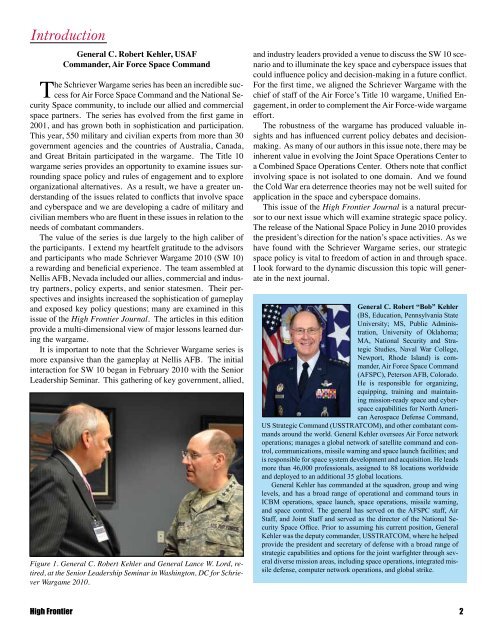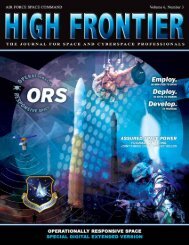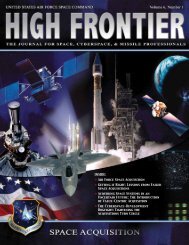Schriever Wargame 2010 - Air Force Space Command
Schriever Wargame 2010 - Air Force Space Command
Schriever Wargame 2010 - Air Force Space Command
- No tags were found...
Create successful ePaper yourself
Turn your PDF publications into a flip-book with our unique Google optimized e-Paper software.
Introduction<br />
General C. Robert Kehler, USAF<br />
<strong>Command</strong>er, <strong>Air</strong> <strong>Force</strong> <strong>Space</strong> <strong>Command</strong><br />
The <strong>Schriever</strong> <strong>Wargame</strong> series has been an incredible success<br />
for <strong>Air</strong> <strong>Force</strong> <strong>Space</strong> <strong>Command</strong> and the National Security<br />
<strong>Space</strong> community, to include our allied and commercial<br />
space partners. The series has evolved from the first game in<br />
2001, and has grown both in sophistication and participation.<br />
This year, 550 military and civilian experts from more than 30<br />
government agencies and the countries of Australia, Canada,<br />
and Great Britain participated in the wargame. The Title 10<br />
wargame series provides an opportunity to examine issues surrounding<br />
space policy and rules of engagement and to explore<br />
organizational alternatives. As a result, we have a greater understanding<br />
of the issues related to conflicts that involve space<br />
and cyberspace and we are developing a cadre of military and<br />
civilian members who are fluent in these issues in relation to the<br />
needs of combatant commanders.<br />
The value of the series is due largely to the high caliber of<br />
the participants. I extend my heartfelt gratitude to the advisors<br />
and participants who made <strong>Schriever</strong> <strong>Wargame</strong> <strong>2010</strong> (SW 10)<br />
a rewarding and beneficial experience. The team assembled at<br />
Nellis AFB, Nevada included our allies, commercial and industry<br />
partners, policy experts, and senior statesmen. Their perspectives<br />
and insights increased the sophistication of gameplay<br />
and exposed key policy questions; many are examined in this<br />
issue of the High Frontier Journal. The articles in this edition<br />
provide a multi-dimensional view of major lessons learned during<br />
the wargame.<br />
It is important to note that the <strong>Schriever</strong> <strong>Wargame</strong> series is<br />
more expansive than the gameplay at Nellis AFB. The initial<br />
interaction for SW 10 began in February <strong>2010</strong> with the Senior<br />
Leadership Seminar. This gathering of key government, allied,<br />
Figure 1. General C. Robert Kehler and General Lance W. Lord, retired,<br />
at the Senior Leadership Seminar in Washington, DC for <strong>Schriever</strong><br />
<strong>Wargame</strong> <strong>2010</strong>.<br />
and industry leaders provided a venue to discuss the SW 10 scenario<br />
and to illuminate the key space and cyberspace issues that<br />
could influence policy and decision-making in a future conflict.<br />
For the first time, we aligned the <strong>Schriever</strong> <strong>Wargame</strong> with the<br />
chief of staff of the <strong>Air</strong> <strong>Force</strong>’s Title 10 wargame, Unified Engagement,<br />
in order to complement the <strong>Air</strong> <strong>Force</strong>-wide wargame<br />
effort.<br />
The robustness of the wargame has produced valuable insights<br />
and has influenced current policy debates and decisionmaking.<br />
As many of our authors in this issue note, there may be<br />
inherent value in evolving the Joint <strong>Space</strong> Operations Center to<br />
a Combined <strong>Space</strong> Operations Center. Others note that conflict<br />
involving space is not isolated to one domain. And we found<br />
the Cold War era deterrence theories may not be well suited for<br />
application in the space and cyberspace domains.<br />
This issue of the High Frontier Journal is a natural precursor<br />
to our next issue which will examine strategic space policy.<br />
The release of the National <strong>Space</strong> Policy in June <strong>2010</strong> provides<br />
the president’s direction for the nation’s space activities. As we<br />
have found with the <strong>Schriever</strong> <strong>Wargame</strong> series, our strategic<br />
space policy is vital to freedom of action in and through space.<br />
I look forward to the dynamic discussion this topic will generate<br />
in the next journal.<br />
General C. Robert “Bob” Kehler<br />
(BS, Education, Pennsylvania State<br />
University; MS, Public Administration,<br />
University of Oklahoma;<br />
MA, National Security and Strategic<br />
Studies, Naval War College,<br />
Newport, Rhode Island) is commander,<br />
<strong>Air</strong> <strong>Force</strong> <strong>Space</strong> <strong>Command</strong><br />
(AFSPC), Peterson AFB, Colorado.<br />
He is responsible for organizing,<br />
equipping, training and maintaining<br />
mission-ready space and cyberspace<br />
capabilities for North American<br />
Aerospace Defense <strong>Command</strong>,<br />
US Strategic <strong>Command</strong> (USSTRATCOM), and other combatant commands<br />
around the world. General Kehler oversees <strong>Air</strong> <strong>Force</strong> network<br />
operations; manages a global network of satellite command and control,<br />
communications, missile warning and space launch facilities; and<br />
is responsible for space system development and acquisition. He leads<br />
more than 46,000 professionals, assigned to 88 locations worldwide<br />
and deployed to an additional 35 global locations.<br />
General Kehler has commanded at the squadron, group and wing<br />
levels, and has a broad range of operational and command tours in<br />
ICBM operations, space launch, space operations, missile warning,<br />
and space control. The general has served on the AFSPC staff, <strong>Air</strong><br />
Staff, and Joint Staff and served as the director of the National Security<br />
<strong>Space</strong> Office. Prior to assuming his current position, General<br />
Kehler was the deputy commander, USSTRATCOM, where he helped<br />
provide the president and secretary of defense with a broad range of<br />
strategic capabilities and options for the joint warfighter through several<br />
diverse mission areas, including space operations, integrated missile<br />
defense, computer network operations, and global strike.<br />
High Frontier 2











